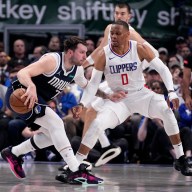 Renee Zellweger and Catherine Zeta-Jones helped put a longtime musical favorite on screen.
Renee Zellweger and Catherine Zeta-Jones helped put a longtime musical favorite on screen.
Credit: Miramax
The Four Seasons catalog was turned into the show “Jersey Boys.” Now the musical is a movie, directed by Clint Eastwood. (See our review here.) It’s not the first stage-to-screen film to originate somewhere else entirely. Here are eight films or stage musicals that have had multiple lives, some starting out as literature — be it respected or disreputable — others as movies, made by people who had no idea their work would one day be turned into stage or movie titans.
Our picks were lovingly chosen by Metro’s theater and film critics, but we’d love to hear about your favorites in the comments!
 Cary Grant tried to get back with ex Katharine Hepburn in the 1940 film of “The Philadelphia Story.”
Cary Grant tried to get back with ex Katharine Hepburn in the 1940 film of “The Philadelphia Story.”
Credit: Moviepix/Getty Images
‘The Philadelphia Story’ schmoozes its way to ‘High Society’
‘The Philadelphia Story’ (1939, play) Set among the city’s moneyed Main Line, Philip Barry’s comedy of manners concerns a socialite whose looming marriage is thrown into disarray by the arrival of her ex-husband and a journalist. Barry wrote the lead, Tracy Lord, for Katharine Hepburn, who played her in the hit film, made the subsequent year.
‘High Society’ (1956, film musical) The film was so beloved that it was remade, this time as a musical (and relocated to Newport, Rhode Island). Grace Kelly stepped in for Hepburn, Bing Crosby and Frank Sinatra for Cary Grant and James Stewart. And though there are plenty of Cole Porter numbers by the main cast, also on hand is Louis Armstrong, who swings by as a kind of Greek chorus.
‘High Society’ (1987, stage musical) It took 30 years, but Barry’s play returned to the stage, transformed into the ’56 musical. After premiering on London’s West End, it took another 11 years to hit Broadway, where the production netted a 12-year-old Anna Kendrick a Tony nomination.
 James Garner thinks Julie Andrews is a man in the 1982 film of “Victor/Victoria.”
James Garner thinks Julie Andrews is a man in the 1982 film of “Victor/Victoria.”
Credit: MGM
‘Viktor und Victoria’ dresses up as ‘Victoria/Victoria’
‘Viktor und Viktoria’ (1933, film musical) Made in the last days of Germany’s hedonistic Weimar Republic, this musical comedy was the first to spin the farce about a woman who pretends to be a female impersonator, therefore convincing her fans that she’s actually a man in drag. (Hopefully this isn’t confusing.)
‘Victor/Victoria’ (1982, film musical) The original was remade several times, in England in 1935, in Argentina in 1975, and in Germany again in 1957. But it only became huge with Blake Edwards’ movie, starring Julie Andrews in double-drag duty (and later Robert Preston in single-drag and banging “Webster” dad Alex Karras) and new songs by Henry Mancini.
‘Victor/Victoria’ (1995, stage musical) Thirteen years later Andrews and Edwards dusted off one of their greatest screen successes, starting it soft in Minneapolis before taking it to Broadway and London. Andrews refused her Tony since the awards had otherwise snubbed the production. A film recording of the stage show was made the same year as its debut.
 A young Jack Nicholson filed one of his first performances in the 1960 Roger Corman cheapie “Little Shop of Horrors.”
A young Jack Nicholson filed one of his first performances in the 1960 Roger Corman cheapie “Little Shop of Horrors.”
Credit: Provided
‘Little Shop of Horrors’ devours itself
‘Little Shop of Horrors’ (1960, film) Even for a Roger Corman production, this dark comedy was penny-pinching: The famously thrifty filmmaker shot it in two days on a $28,000 budget (roughly $225,000 today), on sets left over from his “A Bucket of Blood.” The tale of a man-eating plant, it’s also notable for containing one of Jack Nicholson’s first screen turns, as a hyper-masochist who loves dentists (a role later played on film by Bill Murray).
‘Little Shop of Horrors’ (1982, stage musical) The cult around Corman’s film was such that Alan Menken and Howard Ashman — soon for “The Little Mermaid” — turned it into a campy but loving Off-Broadway musical filled with doo-wop, Motown and power ballads, plus a charming giant puppet that feasts on the cast.
‘Little Shop of Horrors’ (1986, film musical) By the mid-’80s the screen musical had been mostly dead for over a decade, killed by the likes of 1973’s disastrous redo of “Lost Horizon.” But it was alive enough to hoover up a hit show, made by the reliably morbid Frank Oz and with Rick Moranis and Ellen Green killing it as wallflowers trying not to get eaten. The show’s apocalyptic finale was retained, and super-sized, but re-shot after test audiences reacted in horror. This sequence was only officially restored to home video in 2012.
 Divine and Jerry Stiller play wife and husband in John Waters’ 1988 film “Hairspray.”
Divine and Jerry Stiller play wife and husband in John Waters’ 1988 film “Hairspray.”
Credit: Moviepix/Getty Images
‘Hairspray’: The little movie that could
‘Hairspray’ (1988, film) By 1988, some 24 years into making films, John Waters had finally (albeit only briefly) had it with shocking people with people eating poo (“Pink Flamingos”) or being raped by lobsters (“Multiple Maniacs”). He sought to make a nice, PG-rated comedy that recreated 1960s Baltimore, albeit one that dealt with race and physical appearance, plus featured cross-dresser Divine as Ricki Lake’s mom (and Jerry Stiller’s wife).
‘Hairspray’ (2002, stage musical) The film “Hairspray” wasn’t a hit, and it wasn’t until the late ’90s that the right person rediscovered it, realizing it would make a money-gobbling musical. Mark Shaiman came in to do the music, and Waters just sat back with a grin, raking in money and planning his NC-17 sex movie “A Dirty Shame.”
‘Hairspray’ (2007, film musical) Waters hasn’t directed a film in a decade, but he’s doing all right. He’s a “personality” now, who can do talk shows and pop up in documentaries and even safely hitchhike. Meanwhile the musical version of “Hairspray” brought the material back to screens, only with John Travolta doing a rather sad — and overly weak — take on Divine.
 Audrey Hepburn goes from cockney lass to society dame with a giant hat in the 1964 film of “My Fair Lady.”
Audrey Hepburn goes from cockney lass to society dame with a giant hat in the 1964 film of “My Fair Lady.”
Credit: Moviepix/Getty Images
‘Pygmalion’ is coached into ‘My Fair Lady’
‘Pygmalion’ (1912, play) Although the story of Pygmalion has many iterations, starting in ancient mythology and followed by several operatic interpretations (from 1745 on), the most popularized play was written by George Bernard Shaw.
‘Pygmalion’ (1938, film) A British film, starring Leslie Howard and Wendy Hiller, was released in 1938, taking home an Oscar for Best Screenplay. There are many other adaptations, among them a 1983 TV movie with Peter O’Toole and Margot Kidder.
‘My Fair Lady’ (1956/1964, stage and film musical) The 1938 film was later adapted into “My Fair Lady,” a hit musical by Lerner and Loewe debuting in 1956. Julie Andrews and Rex Harrison helmed the original cast, directed by Moss Hart. Andrews was famously not cast in the big budget movie adaptation, which went with Audrey Hepburn instead. It won eight Academy Awards, including Best Picture, though the one that could have gone to Hepburn instead went to Andrews for “Mary Poppins.”
 Johnny Depp (with Sontagian white streak) gets to butchering in the 2007 film of “Sweeney Todd.”
Johnny Depp (with Sontagian white streak) gets to butchering in the 2007 film of “Sweeney Todd.”
Credit: Provided
‘Sweeney Todd’ murders his way through the mediums
‘The String of Pearls’ (1846-1847, penny dreadful) The character of Sweeney Todd was first mentioned in penny dreadful called “The String of Pearls,” which ran from 1846 to 1847. But the famed character broke out on his own in the 1936 film “Sweeney Todd: The Demon Barber of Fleet Street.”
‘Sweeney Todd: The Demon Barber of Fleet Street’ (1979, stage musical) The acclaimed Stephen Sondheim musical came to Broadway in 1979 — but it’s based on the 1973 play by Christopher Bond. Sondheim’s work took home the Tony Award for Best Musical.
‘Sweeney Todd: The Demon Barber of Fleet Street’ (2007, film musical) Following a concert revival that was released on film, Tim Burton directed the movie musical version, which only upped the gore. Alas, stars Johnny Depp and Helena Bonham Carter lacked the vocal prowess to handle Sondheim’s famously complex melodies.
 Ginger Rogers plays a showgirl trying to grift her way to fame in “Roxie Hart,” the 1942 film based on the play “Chicago.”
Ginger Rogers plays a showgirl trying to grift her way to fame in “Roxie Hart,” the 1942 film based on the play “Chicago.”
Credit: Provided
From ‘Chicago’ to ‘Roxie Hart’ and back again
‘Chicago’ (1926, play) “Chicago” started as a play in 1926, based on real crimes and criminals observed by Chicago Tribune reporter Maurine Dallas Watkins. The first adaptation was a silent film starring Cecil B. DeMille in 1927. It was renamed “Roxie Hart” in a 1942 comedic movie starring Ginger Rogers.
‘Chicago’ (1975, stage musical) The Fosse-choreographed musical hit Broadway in 1975. It closed after two years, only to be revived in 1996. Today it’s the longest-running musical revival and longest-running American musical.
‘Chicago’ (2002, film musical) In 2002, a movie musical based on the stage libretto won an Oscar for Best Picture. It starred Renee Zellweger, Catherine Zeta-Jones and Richard Gere, directed by Rob Marshall.
 Let’s try to remember there is a good movie of “The Phantom of the Opera,” and it’s the 1925 one with Lon Chaney, not the 2004 adaptation of the musical.
Let’s try to remember there is a good movie of “The Phantom of the Opera,” and it’s the 1925 one with Lon Chaney, not the 2004 adaptation of the musical.
Credit: Moviepix/Getty Images
The ‘Phantom’ strikes again and again (and again and again)
‘The Phantom of the Opera’ (1909-1910, novel) From 1909-1910, “Le Gaulois” ran a serialized drama by French novelist Gaston Leroux about “The Phantom of the Opera.” The story was translated into a silent horror film in 1925, starring Lon Chaney Sr. This version was followed by a 1943 remake in color starring Nelson Eddy.
‘The Phantom of the Opera’ (1986, stage musical) Following a 1959 ballet by Sir Malcolm Arnold, “The Phantom of the Opera” exploded into mass popularity thanks to the 1986 musical by Andrew Lloyd Webber, which premiered in the West End before moving on to Broadway.
‘The Phantom of the Opera’ (2004, film musical) Webber’s musical become a movie in 2004; it starred Girard Butler and Emmy Rossum, though Minnie Driver often stole the show as secondary character Carlotta. (Also of note is Brian De Palma’s campy “Phantom of the Paradise,” with diminutive Paul Williams as the bad guy.)
 Marcello Mastroianni plays a version of his director, Federico Fellini, in the landmark movie-about-movies “8 1/2.”
Marcello Mastroianni plays a version of his director, Federico Fellini, in the landmark movie-about-movies “8 1/2.”
Credit: Provided
If ‘8 ½’ was ‘Nine’
‘8 ½’ (1963, film) Freaking out over how to follow-up the monster hit “La Dolce Vita,” Federico Fellini turned an abandoned sci-fi project into a ground-breaking movie about movies, concerning a philandering, depressed film director (Marcello Mastroianni) having phantasmagoric visions while struggling to piece together a follow-up to a monster hit.
‘Nine’ (1982, stage musical) So what if theater is not cinema? Fellini’s purely filmic work got a musical anyway, which rounded up the titular number and added an entirely new second act when the director actually makes his film — thus defeating most of the reason for the film’s being.
‘Nine’ (2009, film musical) The garish awards season monstrosity made from the musical snipped the second act off, but that’s about all it got right. An unusually sleepy Daniel Day Lewis did Mastroianni while Kate Hudson reached lows crooning “Cinema Italiano,” a song that requires she screech the name “Guido” for 20 seconds straight.
For our review of the “Jersey Boys” movie, click here. Also see our interviews with director Clint Eastwood, stars John Lloyd Young andVincent Piazza and writers Rick Elice and Marshall Brickman.
Follow T. Michelle Murphy on Twitter @TMichelleMurphy and Matt Prigge @mattprigge
















